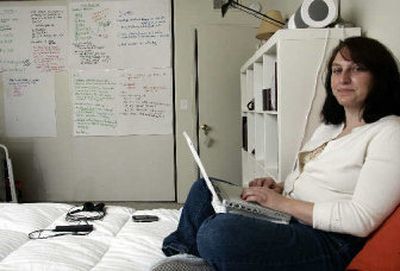Driven to stay home

Imagine being on a Hawaii vacation and stepping onto the hotel balcony to watch the sun rise over the Pacific.
Then the phone rings. It’s a co-worker from the mainland. Ready for the conference call?
It happened to Darlene Frudakis, president of PetAg Inc., a Hampshire, Ill.-based pet food maker. Even more surprising was Frudakis’s reaction.
“It was just a fabulous feeling,” said Frudakis, a full-time telecommuter who is very comfortable blurring the line between work and play. She relishes the “freedom and creativity … to think outside the box” that comes with being physically detached from her company’s headquarters — whether that is at home in Novato, Calif., or on vacation — and says that makes her more productive.
Still, there is a downside to a lifestyle in which the “office” is really a state of mind: “You can’t leave,” she said.
More than 30 years after the lifestyle began inching into mainstream corporate culture, and in spite of the potential pitfalls, there were almost 14 million Americans telecommuting at least part time in 2004, and an additional 7 million running businesses from home, according to the most recent Labor Department data.
In 2005, 44 percent of U.S. companies offered at least some telecommuting options, according to a survey 1,043 large employers by Mercer Human Resources Consulting. That is up from 32 percent in 2001.
In the post-9/11 era, corporate America views a work force that can function remotely as a strategic advantage, experts said.
“The reason I think it’s gaining momentum is because of natural-disaster preparedness,” said Ellen Galinsky, president of the New York-based Families and Work Institute, a nonprofit that researches work force trends for corporations. Galinsky said it was the less centralized companies that were up and running fastest in the days following the Sept. 11 terrorist attacks.
Maryella Gockel, who oversees flexible work scheduling at Ernst & Young in New York, believes it is still the employees who are driving the trend. At first the telecommuting bandwagon was led by new mothers who wanted to have more time with their children, she said. Then dads sought similar arrangements. And, finally, employees without children began requesting the same kind of scheduling options their co-workers were receiving — they wanted to devote more time to a hobby or just spend less time in traffic.
Bill Rocco, a mutual fund analyst for Chicago-based Morningstar, has been telecommuting for about nine years, initially from Corvallis, Ore., and now from Ashland, Ore. — a lifestyle he chose so that he could more easily indulge his love of the outdoors. He is at his desk by 7 a.m. — usually in shorts and sneakers — in order to work the same hours as his colleagues in the Central time zone.
Unlike Frudakis, Rocco said “it is really important to draw that boundary” between work and leisure, something he does by turning off the phone at the end of the day and before weekends. “Otherwise it would be too easy to work all the time,” he said.
Kristen Havens, who markets books online from her Los Angeles apartment, e-mails frequently with her employer, but said that “socially, it is more isolating” than being in an office. Havens, an aspiring screenwriter, also writes a blog, and concedes this may be her way to make up for the lack of watercooler chatter in her life.
But these challenges are offset by perks, said Havens, who doesn’t miss loud co-workers and loves being able to go to the gym at less busy hours.
More than a dozen people who telecommute or work from home said in interviews that they feel ever more connected to the workplace thanks to high-speed Internet connections that facilitate a steady flow of e-mail, teleconferences and instant messaging — the modern day equivalent of a tap on the shoulder. Moreover, the growing reliance on such non-face-to-face communication inside the traditional workplace, suggests to them that the distinction between these two worlds is beginning to break down.
“People do get isolated in the cube,” said Kevin Remlinger, an information technology project manager for San Jose, Calif.-based Cadence Design Systems Inc. who works remotely from his home in Timonium, Md.
By contrast, Remlinger said being a telecommuter forces him to be more proactive about developing solid relationships with co-workers. Remlinger said he spends about four hours a day on teleconferences — — and that as a result “we know each other pretty well.”